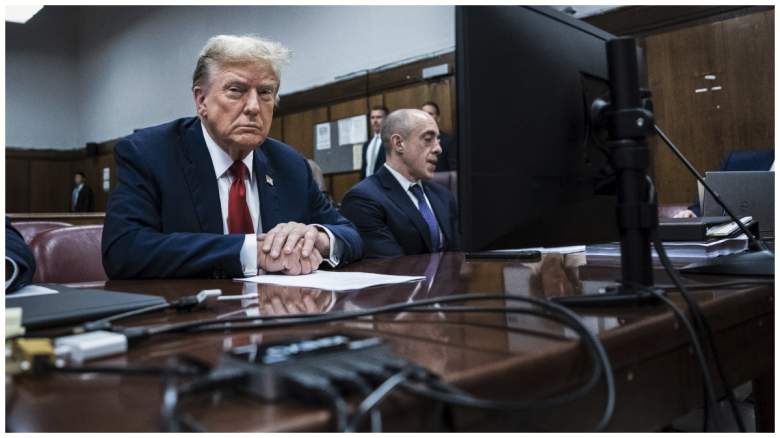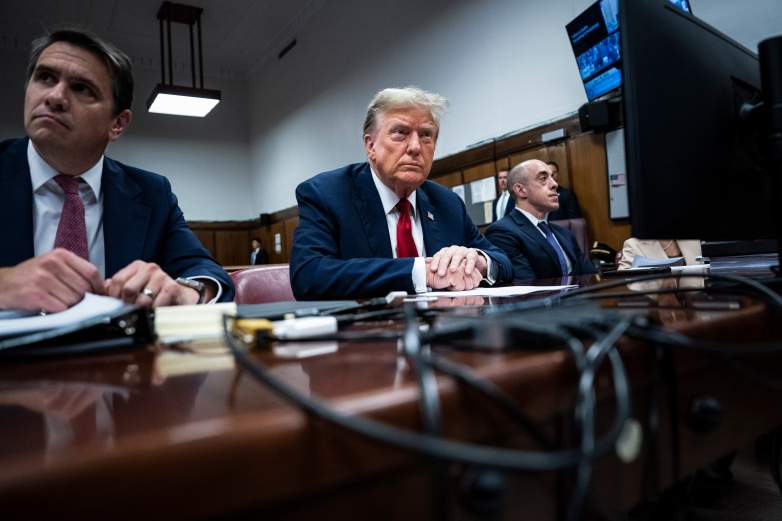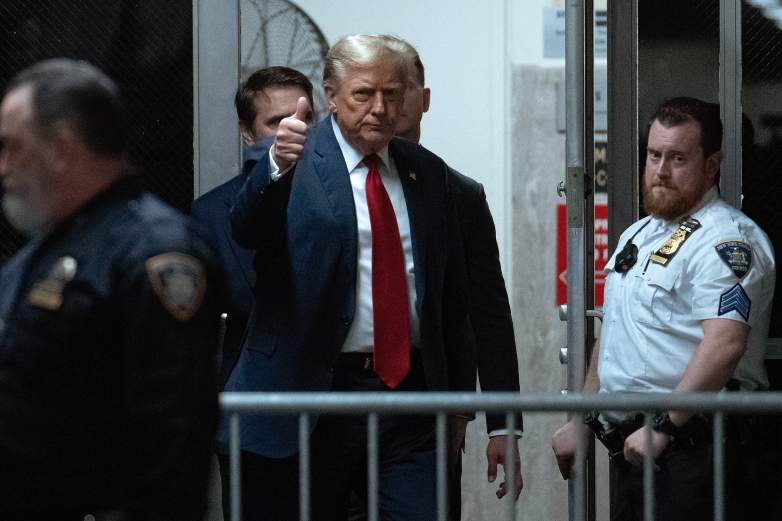
Getty Trump's trial is not available on live stream video.
Former President Donald Trump is on trial in Manhattan, with jury selection commencing on April 15. However, there will not be a live stream or recorded video or audio available of the Trump trial proceedings. That means that the public will have to learn about the historic trial via reporting from journalists who are present and a courtroom sketch artist.
New York laws and rules on videotaping court proceedings are complex, and such videotaping is rare, although possible if allowed by the judge upon application by the news media. That’s according to New York civil rights laws that prohibit broadcasting some proceedings, as well as state rules. Only still photographers were allowed into the courtroom on April 15, for a few minutes:

GettyFormer U.S. President Donald Trump (C) appears with his legal team, Todd Blanche and Emil Bove (R), ahead of the start of jury selection at Manhattan Criminal Court on April 15, 2024, in New York City.
Trump is accused of falsifying business records in more than three dozen felony charges. The case involves hush money payments to former porn star Stormy Daniels. Trump has maintained his innocence and raised statute of limitations, jurisdictional, and other questions, including the prosecutor’s and judge’s Democratic ties.
The Associated Press recorded video outside the courtroom building on April 15 but not inside it.
Court proceedings in Trump’s Georgia criminal case were televised. Other high-profile trials – O.J. Simpson, Amber Heard/Johnny Depp, the Kyle Rittenhouse trial in Wisconsin, have been broadcast live to the public, but rules for that vary by state.
Here’s what you need to know:
Reports Say News Organizations Did Not Submit Any Applications to Cover the Trump Trial With Video or Audio After the Arraignment

GettyTrump’s trial is not available on live stream video.
The New York Court System does have a rule section titled, “Audio-Visual Coverage Of Judicial Proceedings.” It reads,
In order to maintain the broadest scope of public access to the courts, to preserve public confidence in the Judiciary, and to foster public understanding of the role of the Judicial Branch in civil society, it is the policy of the Unified Court System to facilitate the audio-visual coverage of court proceedings to the fullest extent permitted by the New York Civil Rights Law and other statutes, as interpreted by New York courts, pursuant to the rules set forth below.
The section then states, “Coverage of judicial proceedings shall be permitted only upon order of the presiding trial judge approving an oral or written application made by a representative of the news media for permission to conduct such coverage.” The judge is then supposed to consider a number of facts, including whether the proceedings would involve “lewd or scandalous matters” and the type of case involved.
The rules then state that “following review of an application for coverage of a judicial proceeding, the presiding trial judge, as soon as practicable, shall issue an order, in writing or on the record in open court, approving such application, in whole or in part, or denying it.”
According to USA Today, when it comes to the Trump trial, “Records show an application was submitted to cover the arraignment, but not the trial.” Judge Juan Merchan denied the request for the arraignment coverage, USA Today reported.
Heavy has written the New York Court System’s public information office to confirm the USA Today report that no applications were submitted to cover the trial.
According to CNN, “While many states frequently broadcast trials, New York state civil rights law limits what is allowed. The judge, Juan Merchan, could in theory make an exception, but he did not allow cameras to broadcast Trump’s arraignment last year.”
The Radio Television Digital News Service states that video and audio cameras and webcasts are allowed in courtrooms in New York with the judge’s permission.
“Although Section 52 of the Civil Rights Law imposes a ban on televising of trial court proceedings, New York Codes, Rules and Regulations (NYCRR) Section 29.3 provides that any media coverage of trial court proceedings is governed by the administrative court rules laid out in NY Consolidated Laws (NY CLS) Section 131,” the RTDNS reports. “Updated in 2016, Section 131 states that coverage is permitted by the presiding judge.”
However, that page continues, “Media personnel may request permission to broadcast and record in any trial proceeding that does not include a witness or party testimony. Consent of all parties is not required for the judge to grant permission. Only two video cameras with two camera operators and two still cameras with two photographers are permitted during a given proceeding. The presiding judge will determine where the equipment shall be placed.”
Former President Donald Trump Opposed Having Video & Audio Recording in the Courtroom During His Earlier Arraignment

GettyFormer U.S. President Donald Trump returns to the courtroom after a break during the start of jury selection for his trial at Manhattan Criminal Court on April 15, 2024 in New York City. Former President Donald Trump faces 34 felony counts of falsifying business records in the first of his criminal cases to go to trial.
News organizations asked to cover the arraignment. They wanted the judge to allow access to the arraignment of “print journalists … [and] a limited number of videographers, photographers, and radio journalists,” the judge’s order says.
The document says Trump opposed the trial being televised. “Defendant opposes the news organization’s application and asks that it be denied. Defendant expresses fear that granting the application will create a circus-like atmosphere … raise security concerns and is inconsistent with President Trump’s presumption of innocence,” the court document says.
Trump argued that the “heightened media presence” would “inevitably result in prejudice” and “detract from both the dignity and decorum of the proceedings and will necessarily interfere with the fair administration of justice,” the court documents say.
The Manhattan District Attorney took “no position” on cameras at the arraignment but said they would raise “a number of concerns” including “the prejudicial impact of pretrial publicity on the jurors, the impact on the truthfulness of the witnesses, responsibilities placed on the trial judge to assure a fair trial, and the impact on” Trump.
Merchan has come under scrutiny and a denied recusal request from Trump for a total of $35 in campaign donations he made to President Joe Biden and Democratic groups. Trump has also raised the judge’s daughter’s leadership at a firm that made millions of dollars from Biden and Vice President Kamala Harris’s campaigns but he has not been gagged from talking about the judge’s family. Merchan wrote:
That this indictment involves a matter of monumental significance cannot possibly be disputed. Never in the history of the United States has a sitting or past President been indicted on criminal charges. Mr. Trump’s arraignment has generated unparalleled public interest and media attention. The populace rightly hungers for the most accurate and current information available. To suggest otherwise would be disingenuous. Understandably, the News organizations want to fulfill their responsibilities and argue that obtaining the broadest possible public access helps advance that mission. Unfortunately, although genuine and undoubtedly important, the interests of the news organizations must be weighed against competing interests. This Court is now called upon to engage in that balancing exercise.
When it came to the arraignment, the judge ultimately agreed to allow five pool still photographers into the courtroom for several minutes but refused to grant the news organizations a hearing on their request to have video and audio in the courtroom, denying it.
READ NEXT: Milwaukee Man Accused in Dismemberment Murder of Young College Student